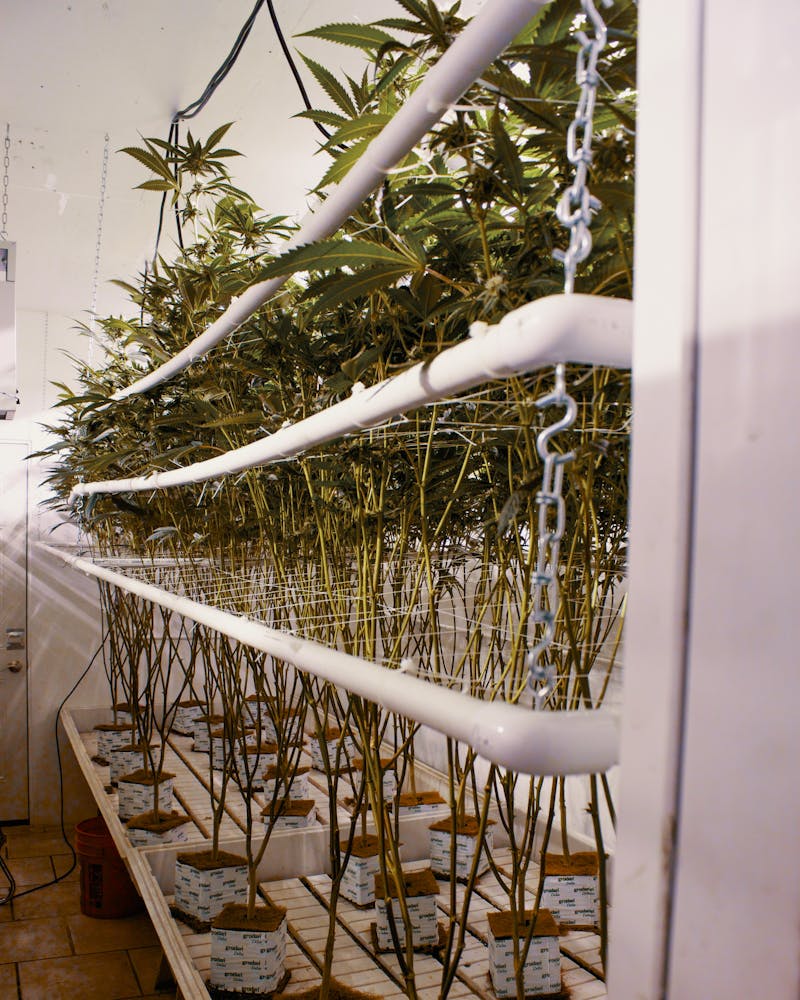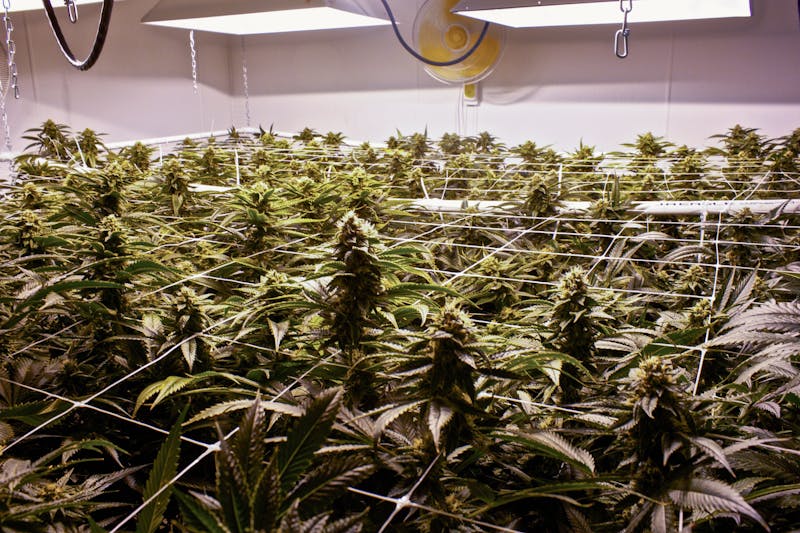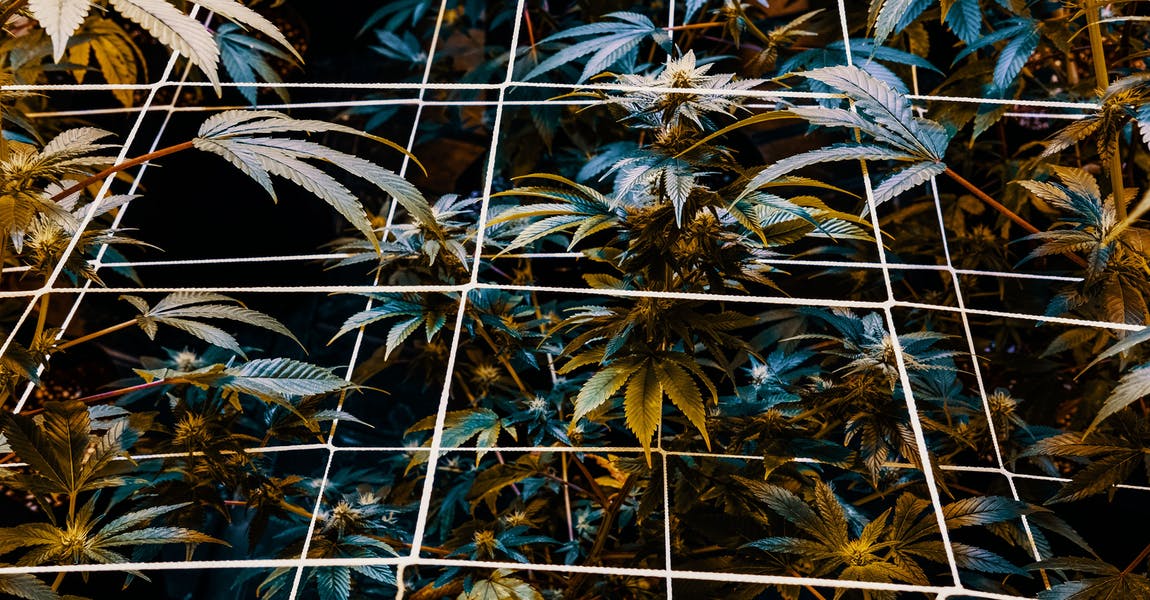Cultivation, Educational
What is SCROG?: Save Space and Yield More Bud With the Screen of Green Method
Photography by Oriana Koren for Herb
SCROG, short for “screen of green,” is an indoor cannabis training technique. There are many different techniques that help indoor growers maximize their space, but scrogging is one of the most popular.
What is ScrOG?
SCROG is a training technique that helps indoor cannabis cultivators maximize their light usage and the number of top buds, or colas, their plants produce. If you leave a single plant in a pot to grow without training, chances are it will develop just one central cola. With SCROG, however, every branch develops into a decent-sized cola. This coaxes out high yields from as few as one to five plants.
Basically, to create a SCROG, growers place a screen—which looks like a large metal grid—about 15 inches above their indoor weed plants. Once cannabis branches grow through the screen, cultivators train them to grow outwards rather than upwards by bending the stalks and tying them to the screen.
Scrogging is usually combined with another technique called topping. Topping is basically trimming the tops of your cannabis plants to promote outward growth. When you top your plants, you’re helping them to grow more branches and also become bushier. Then, when you scrog, it helps to expose every inch of those branches to lights. That way, a scrog helps indoor growers use their grow lights most efficiently.
Scrog vs. Sog
The sea of green (SOG) method is another type of growing technique that encourages high yields. In a way, it is the exact opposite of SCROG. SCROG uses a few plants and creates multiple, highly developed budding sites. SOG, however, uses many plants (30 to 40) and focuses on the development of one primary cola.
After clones are given 1 to 2 weeks to establish, they are switched into flowering. This causes the clones to go into overdrive. Their stalks begin to thicken and they start to produce a single, impressive flower.
The SOG technique is quite a bit faster than SCROG. The SOG method is typically used by professional growers who need high yields very quickly. SCROG is better for the average home grower, who wants to get a ton of product out of just a few plants.
While sativas take nicely to SCROG, indicas are best suited for the SOG method. Plants in SOG rarely reach a height of more than 12 inches (30 cm).
The high number of plants used in the SOG method also makes for greater legal troubles in some areas. In most legal states, you can only grow 4 to 6 plants. This makes SCROG a better option for most people.
Overall, you can get a similar yield using both methods.
Why use the SCROG method?

Growing cannabis indoors can get expensive because the lights needed to promote healthy growth use a lot of energy. That’s why the SCROG method was invented. With the SCROG method, each budding site receives the same amount of light, promoting many large colas and using the whole grow room most efficiently. Plus, there’s no taller plants to cast shadows onto shorter plants, everything’s more or less the same height in the screen of green.
Scrogging is super useful for indoor growers in both illegal states and those in places with a small cap on the number of legal plants they can grow. For instance, it’s great in Canada where home growing is permitted but most provinces only allow each household to grow four plants. Four plants using the SCROG method will yield more high-quality flowers than four plants without. Plus, all of the buds will be top-shelf quality colas. There will never be soft buds on bottom branches that never fully ripen.
Scrogging is also useful for growing sativas indoors. Sativas, unlike indicas, are tall plants and continue to stretch through flowering. While that’s not a problem outdoors, it is very likely they’ll hit the ceiling if they’re being grown indoors. That’s why many indoor growers use a screen of green, to keep sativas short and to maximize their indoor yields and light usage.
Another benefit of scrogging is indoor growers can bring their grow lights to their lowest possible level. That’s important because light intensity is one of the most crucial aspects of successfully growing weed inside. At the same time, however, if some plants are taller than others, bringing grow lights lower isn’t an option because the tallest plants may get burned. With the screen of green method, burning taller plants won’t be an issue because they’re all the same height. Just be sure that your grow room doesn’t exceed about 77 degrees Fahrenheit or you’ll risk killing or damaging plants.
Basically, with scrogging, you’re getting the highest quality buds possible for your energy costs, or the most “buds for your buck.”
Where to SCROG?

The SCROG method is generally used in indoor gardens to maximize yield and light usage. Whether that’s in your apartment, basement, closet, old fridge, or grow box, scrogging can help. Scrogging is less necessary outside because growers are not trying to optimize their artificial light usage. However, other training techniques are popular to maximize outdoor grows. Check out our guide on How to Grow Weed Outdoors to learn more.
Master Scrogging Tips
Scrogging not only helps you get the most buds for your buck, but it’s also fun and rewarding. And you’ll learn a ton about how the cannabis plant grows in the process. Here are some expert tips to help you maintain a healthy and successful screen of green.
Trim Leaves
The leaves of the cannabis plant can cast shadows that will limit the amount of light your plant’s budding sites can get. That’s why trimming some of those leaves is crucial to successful cannabis cultivation. Not to mention, for a cannabis plant to produce leaves at all it takes energy. So trimming leaves allows the plant to focus more of its limited energy on growing big buds that are frosted with trichomes. However, also remember that you can’t trim all the leaves because the plant uses them to collect energy from the grow lights. It’s a balancing act to be sure but striking the right balance will help to maximize your indoor garden.
Proper Air Circulation
All indoor growers have to pay special attention to air circulation, but it’s extra important when using the SCROG method because it creates a thicker canopy. If the air in your screen of green is stale, it’s breeding grounds for infection, disease, and mold. Make sure your grow room has adequate circulation by installing fans and ways to limit the heat your grow lights produce.
If possible, use an air-cooled light. Make sure you have at least two fans going: one to pull fresh air into your grow room/tent, and one pulling hot air out of your space.
As mentioned before, one of the nice things about SCROG is that it can save time while watering. Make sure you only water when your soil is completely dry. Overwatering is one of the most common rookie growing mistakes, and it will only increase your chances of a mold, pest, or pathogen outbreak.
Well, that’s it. Those are the basics of SCROG. This technique will give you a lot of bang for your buck and, hopefully, won’t be too challenging with this guide.
Did we miss something crucial about scrogging? Let us know in a comment below.
Read more from the source: Herb.co
Photography by Oriana Koren for Herb


